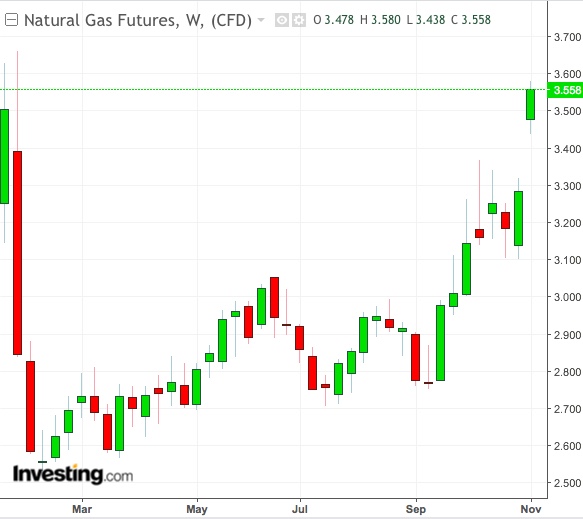With mid-$3 levels proving to be the new normal for natural gas since summer, growing bets for strong heating demand from the winter ahead are prompting some traders to ask: can $4 pricing, last seen during Christmas 2014, be possible this time?

The front-month December contract on the New York Mercantile Exchange hit near 10-month highs above $3.58 per million British thermal units on Tuesday as forecasts for cold weather through next week began to solidify. But the market retreated almost immediately after that, raising questions on whether the spike came too soon before the freeze.
Adding to the uncertainty was Thursday’s storage data showing U.S. gas inventories rose by 65 billion cubic feet last week versus expectations for a 55-bcf build. It was the largest supply injection in a month and coming late in the fall season, when a net draw from storage might have been more appropriate.
Lower Temperatures Needed
Yet, natural gas bulls argue that if temperatures dip to the low 40s Fahrenheit (under 5 Celcius) for more than a few days in the coming two weeks, then NYMEX’s prompt-month for gas might find itself heading for the next resistance level—the high mark of $3.66 set during the 2017/18 winter.
From there, if the weather and technical charts remained supportive, it could get to under $3.77, based on some projections.
Dan Myers, natural gas analyst at Gelber & Associates, said:
“Breaking through these levels would clear the way for the prompt to approach its next key stop at $4/mmBtu this winter.”
But to temper that bullish outlook, Myers also urges the trade to consider some weather models pointing to milder-than-normal temperatures this November and the potential for continued record highs in gas production that could keep supplies strong and prices just moderately higher through winter 2018/19.
Production Also Key
Myers added:
“It will be important to see how production performs in the Northeast during the cold period in the coming days during its first test of the winter.”
Reuters reported that were 72 heating degree days last week, compared with 93 HDDs in the same week a year ago and a 30-year normal of 80 HDDs for the period. HDDs measure the number of degrees a day's average temperature is below 65 Fahrenheit (18 Celsius). The measure is used to estimate demand to heat homes and businesses.
While last week’s injection of 65 bcf, gas in storage is currently near 3.21 trillion cubic feet—adequate to heat an average winter, say analysts. But an extremely cold event could still leave the market severely undersupplied, forcing utility companies to depend on coal as an alternative fuel source.
LNG Exports Could Help Drain Storage
Scott Shelton, broker for energy futures at (ICAP) in Durham, North Carolina, said storage data for the next two weeks—the first forecast to see a build 38 bcf and the latter, a draw of 72 bcf—will be pivotal to determining direction. He said:
“Whether or not that -72 is correct is probably going to be more important for the market than whether or not the 38 for next week is correct.”
Gas bulls also say strong US exports of liquefied natural gas (LNG) this year have helped support $3 pricing by diverting gas not used for current heating or cooling during the summer from ending up in storage.
Myers acknowledged that LNG exports have trended higher this week, fluctuating above 4 bcf a day at times. He added that producer Cheniere reported new output at its Sabine Pass facility this week amid improved flows of LNG to its Corpus Christi base.
Shelton said the divergence in market views had led speculators to hold off from piling into NYMEX’s front-month after this week’s near 10-month highs. He added:
“But I think there may be another wave of buying coming to get them to 100% long should we continue to hold at these price levels.”
